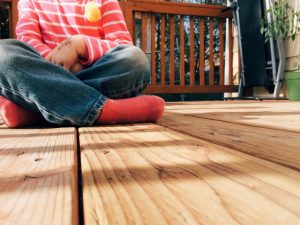Spring has sprung, and fortunately, that means we’ll be spending a lot more time outdoors in our gardens. Many people will be spending this time on a wooden deck, overlooking their gardens whilst reading, or enjoying a barbeque. But the winter weather may have taken its toll on your decking, leaving it looking dirty, grey, and uninviting. Fortunately, it’s possible to breathe new life into it by sanding it down and retreating it.
But how exactly can you go about this, and can you use a floor sander to do it?

These questions and more shall be answered in the article below!
Can you use your floor sander on your deck?
The short answer to the title of this post is: it depends. There’s a lot of competing views on whether or not floor sanders can be used to sand your deck, with valid arguments on both sides. But, realistically, it isn’t the best way to go about sanding down your deck. We’re going to go through the best way to prepare your deck for re-varnishing, before explaining how you could use a floor sander if that’s all you have to hand.
How to Sand a Deck: Sanding your deck without a floor sander
Step 1: Preparing the deck
It’s important to clean your deck thoroughly before sanding it down. Use a jet wash to clean off as much grime as possible. But be careful, if your deck is made of a soft wood like pine, spruce, or cedar, you’ll want to make sure you don’t damage the wood. Make sure you use a wide fan and don’t hold the nozzle too close to the deck.
After this, if the decking has a lot of old product still on it, you’ll need to use a paint or stain remover to take this off. But don’t use anything too harsh, otherwise you might damage the wood itself!
Step 2: Sanding the deck
You’ll want to make sure you choose a day on which there is very little chance of rain. If the wood gets wet after it’s been sanded, but not before it’s been stained or painted, then you’ll have to start all over again, and no one wants that!
When it comes to sanding tools, the best way to sand down your deck is to use a hand-held belt sander. Although many people will be tempted to use a floor sander, these have a number of shortcomings, including their size and weight (which could damage your deck), and the fact they can only sand perfectly flat surfaces. Most decks will have a slight curve in them, so a floor sander just won’t do the job.
Make sure you use proper safety gear as well. A respirator is a must, as well as eyewear. Start with a bet sander with a heavy grit belt (around 50) and work your way along the boards. Then, use a palm sander to get those bits the belt sander couldn’t reach. Finally, repeat this process with a lighter grit sandpaper in order to get a smooth surface.
Step 3: Treating the deck
Use a leaf blower, or broom to remove any of the dust you’ve left after sanding the deck down. It’s important to know that clear coats of stain give very little protection. They’re also very thin, so you’d have to reapply them a lot more frequently. For large surfaces like a deck, you’re going to need a solid stain or paint in order to protect it. It’s also important to use a proper stain brush to make sure the coat on the deck is even, and it works its way into the wood.
Sanding your deck with a floor sander
It is possible to use a floor sander to sand your deck, although we still advise you to use a hand-held belt sander for best results. The steps for sanding with a floor sander are very similar to the ones described above, except you replace the step using the belt sander with using the floor sander. Again, start with a heavy grit sandpaper and gradually move to a finer one to get a smoother finish. Just make sure to go slow and steady to get an even finish, and make sure all parts of the deck have been sanded down. Then continue the steps as usual!
We hope you found this information useful – let us know via Facebook or Twitter what you’d like to learn more about, or what you found most interesting!
